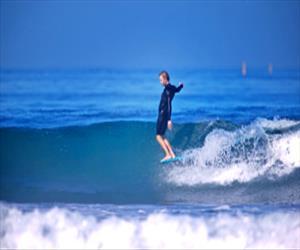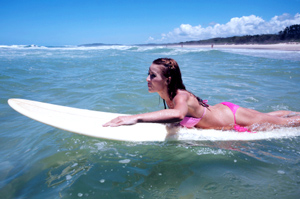How to Choose a Longboard for Surfing
 Ancient Hawaiian surfboards were weapons. They were solid slabs of wood ranging from 10 to 30 feet in length and weighing anywhere from 100 to 200 pounds — with no fin. Longboards have evolved significantly since then. These days, there is a broad array of classic and modern designs available.
Ancient Hawaiian surfboards were weapons. They were solid slabs of wood ranging from 10 to 30 feet in length and weighing anywhere from 100 to 200 pounds — with no fin. Longboards have evolved significantly since then. These days, there is a broad array of classic and modern designs available.
There are several factors that influence whether a board will be a good match for your abilities, surfing style, mass, and wave preferences. This guide will give you some features to consider before you purchase your next longboard.
Longboard Design Influences
Every surfer has an individual set of goals, needs, wants, and abilities. As a result, different combinations of longboard characteristics have been developed to optimize board performance. Here are the main factors to consider when choosing a longboard design:
- Surfing style: Longboarders who surf with a more traditional or classic style usually want a board built for noseriding. Modern-style rippers generally favor the newer, high-performance designs.
- Ability: Advanced surfers often choose more maneuverable models. Less skilled longboarders normally feel most comfortable on a board built with stability in mind.
- Wave types: A longboarder who likes to charge on bigger days will need a board made to perform well at higher speeds. A surfer who enjoys smaller surf will prefer a board designed to maintain speed.
- Paddling effort: Surfers who prioritize catching waves earlier and more easily over performance tend to desire a board that glides through the water very well.
- Mass: A heavier surfer — as opposed to a light-weight surfer — will generally prefer a board that has more float.
Materials
Longboards are constructed with a variety of different materials. These are the most common:
- Balsa: Due to its high strength-to-weight ratio and flex properties, this type of wood has been used in longboard construction for several decades. Today, you can find a wide variety of classic and modern surfboard designs made from balsa — both solid wood and hollow boards. Some longboarders prefer balsa boards and feel that they perform very well, especially in choppy conditions.
- Foam and fiberglass: A polyurethane foam board with a balsa stringer(s) and covered in fiberglass has become the combination of choice for most shapers and many mass-producers. The weight and durability of these boards depends on the number of stringers and the amount of glass that is used. Many surfers are hooked on the “snappy” feel that foam-and-fiberglass constructed boards have when they’re new. These boards do, however, tend to become less lively with use.
- Epoxy: These boards have become very popular with mass-producers in recent years and tend to be the lightest and most durable longboards in the water. Despite fewer ding repairs, however, a lot of surfers feel that epoxy boards are too light and don’t work well when it’s windy and/or the waves aren’t glassy.
Length
Longboards can range anywhere from 8 to 14 feet in length, but the majority of them are between 9 and 11 feet long. A longer board will normally glide better, paddle easier, and allow a surfer to get around wave sections more successfully. However, a longer board will also generally be more difficult to maneuver, require more set-up time, and is usually less responsive.
In 1917, legendary surfer Duke Kahanamoku rode a monster wave (generated by a Japanese earthquake) at a break called Castles in Waikiki, Hawaii. He took this ride on a 16-foot long, 114-pound olo-design board without a fin. The wave is estimated to have been somewhere between 30 and 50 feet high and some believe Kahanamoku rode it for well over a mile!
Volume
The density (materials dependent) and total volume of a longboard will determine how buoyant it is and how well it will paddle. Volume is affected by how thick the board is, as well as the template or general outline — most longboards tend to be in the 70-to-100 range in cubic centimeters. Longboards vary greatly in terms of thickness, but are generally between 2.5 and 3.25 inches thick in the middle, tapering into a thinner nose and tail. The shape will also affect total surface area; the greater the surface area the faster the board will paddle. In addition, balance is key when it comes to volume. Surfers need some buoyancy so a board will glide and maintain board speed. A longboard with excessive float, however, will ride too high in the water and perform poorly.
Shape
The three-dimensional shape and surface characteristics of a longboard will greatly affect how it performs.
- Nose and tail designs: Longboards with a flat, blunt nose and a square tail tend to be the best boards for nose riding. Tails that produce drag slow the board down to keep you in the sweet spot of the wave. A longboard with a narrower nose and pintail are generally seen on high-performance models that are built for more speed.
- Width dimensions: A more narrow and straight longboard will usually be faster and work better in bigger waves, while a more round and curvy shape will tend to be slower but more maneuverable. Most longboards blend the two for versatility. For example, a 10-foot board designed for long nose rides usually has an 18-to-20-inch nose, a 23-to-24.5-inch middle, and a 14.5-to-17-inch tail. In contrast, a 9-foot longboard built for a more modern surfing style often has a 17-to-18-inch nose, a 22-to-23-inch middle, and 13.5-to-15-inch tail.
- Bottom contour: Boards meant for nose riding also generally have a rounded bottom for most of their length. They are designed this way in order to slow the board down. However, the board will be concave under the nose to help surfers speed up once they transfer their weight forward. On the other hand, a higher performance model might have less of a concave at the nose and a double concave at the tail of the board.
- Rails: Soft edge, full rails won’t dig in or sink into the wave as much and will be better for smaller, slower waves and a more flowing surfing style. Harder edge, low-volume rails are best for sinking it into the wave during a turn. As a result, hard edge, narrow rails are normally preferred for bigger, faster surf, and offer more control.
- Rocker: As a rule of thumb, more rocker equals a slower but looser board. Less rocker (flatter) will result in a faster board that’s tougher to turn. Longboards with more rocker are generally designed for bigger surf, while boards with less rocker work well in smaller surf. So for those surfers who want their board to be versatile, it’s best not to go to either extreme when it comes to rocker.
Weight
 Construction materials, shape, size, volume, glass, and fins all influence the weight of a longboard. As a result, total mass can vary widely. The majority of longboards weigh between 20 and 40 pounds, and the most popular designs are generally between 24 and 32 pounds. A single pound can make a huge difference in how a board performs — and optimal board weight is a matter of opinion.
Construction materials, shape, size, volume, glass, and fins all influence the weight of a longboard. As a result, total mass can vary widely. The majority of longboards weigh between 20 and 40 pounds, and the most popular designs are generally between 24 and 32 pounds. A single pound can make a huge difference in how a board performs — and optimal board weight is a matter of opinion.
Some surfers prefer a heavier board, because they feel that the board provides a smoother ride and holds or penetrates the wave well. Others favor a lighter board and feel that they can maneuver it better. It’s important, however, to never assume that a heavier board will not turn easily. It’s not that simple. Maneuverability is a function of the length-to-weight ratio, as well as board shape and fin characteristics.
True Test
Surfboard design is both a science and an art. Subtle variations can mean the difference between the perfect longboard to add to your quiver and a log that simply doesn’t work. Bottom line: A lot of boards look sweet out of the water, but you’ll need to get it wet in order to truly know whether the two of you will click.
